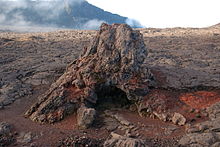Hornito

A hornito on the island of Réunion

An example of a hornito on Hawaii that has built lava spatter deposits into a mound over its vent
Hornitos are conical structures built up by lava ejected through an opening in the crust of a lava flow.[1] Hornitos are similar to spatter cones but are rootless, meaning they were once a source of lava but that source was not directly associated with a true vent or magma source.[1] They are usually created by the slow upwelling of lava through the roof of a lava tube.[1] High pressure causes lava to ooze and spatter out. The lava builds up on the surface and solidifies creating the initial structure. Hornitos can grow and exceed 10 meters in height.[2]
References[]
| Wikimedia Commons has media related to Hornitos. |
- ^ a b c Larson, Charles V. (1993). "An Illustrated Glossary of Lava Tube Features": 56. Cite journal requires
|journal=(help) - ^ VHP Photo Glossary: Hornito, 2009-02-25, retrieved 2009-08-18
External links[]
Categories:
- Volcanic landforms
- Volcanology stubs